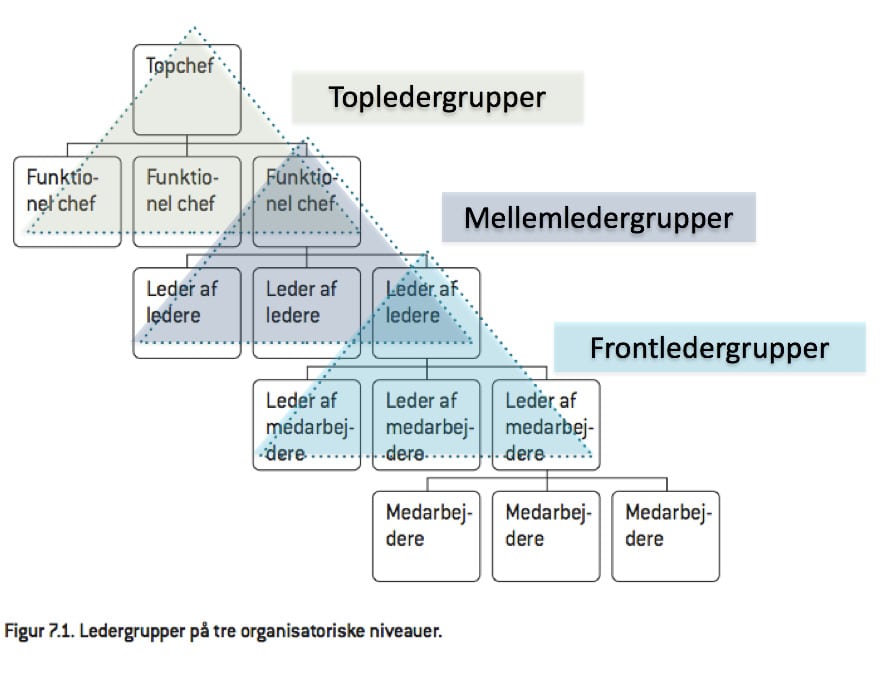Organizations are typically made up of leadership teams at different levels, but it is not always understood that leadership teams at different levels have different tasks and responsibilities, and therefore a number of level-specific characteristics and challenges. This is supported by leadership pipeline thinking, which suggests that good leadership depends on where you are in the leadership hierarchy. This basic thinking about different levels of leadership also applies to leadership teams.
In most large organizations, the management chain consists of three levels of management teams:
- Top management teams
- Middle management groups
- Frontline management groups

Top management teams
Top management teams have certain characteristics. These characteristics are due to their position and function in the overall organization and set them apart from other levels of management.
Firstly, top management teams are characterized by the fact that they have a special responsibility for the organization's strategic decisions. Their main task and responsibility is to set the overall organizational benchmarks such as strategies, overall goals and the framework for the organization's culture.
The senior management team is responsible for all key decisions regarding the organization's strategy, structure, culture and governance. As such, they face a particularly complex task. It's the top management team that makes the fundamental decisions about the "playing field" for other members of the organization. In addition, the work of top management teams is typically more complex and unstructured because the framework is not set in advance. At the same time, their decisions and choices have major implications for the entire organization.
Another characteristic of top management teams is that they must be able to integrate and balance often conflicting demands and expectations from boards, owners, employees, other managers, customers and competitors. A crucial and extremely important task. These conflicting interests must be balanced with a razor-sharp focus on the best interests of the organization. Working under such conditions easily results in power struggles, which is why the ability to manage power struggles and conflicts of interest also plays a key role in top management teams.
In addition, a factor that deserves special attention and can be a pitfall in top management teams is that they are typically made up of people with certain traits. Top leaders are typically achievement-oriented and individualistic, and have often been selected through a series of promotions based on their individual performance. This can be used constructively in top management teams, but it can also be a tripwire that can have a negative impact on the ability to establish good collaboration in the management team.
There is good reason to invest time and resources in the development of top management teams, which is both the most important management team to get right because it affects the entire organization, and the hardest to get right.
LEADERSHIP IN PRIVATE COMPANIES
Get a tailored program that solves the challenges you face now - and in the future
We help you drive business results by developing your leadership capacity, speed and flexibility. We do this by drawing on new research-based knowledge of what works, combined with many years of experience with results-driven leadership in other private and public companies.
Middle management groups
Middle management teams, located in the middle of the management chain with extensive upward, downward and cross-functional relationships, have a different role than top management teams. The work of middle management teams is about translating and making sense of decisions downwards, coordinating across the organization and providing feedback upwards.
A crucial competency of middle management teams is therefore mastering strategy development up to the top management team while ensuring implementation downwards. Another key competency of middle management teams is their ability to lead through the management teams below them in the management hierarchy by delegating and supporting them in making employees succeed.
In middle management teams, which typically consist of managers who report to a boss, the strategic direction and goals are already set. The task is to translate and implement these down through the organization. In this context, middle management groups have a special role as translators and opinion makers in the organizational cross-pressure with top management with demands for development, earnings and efficiency on the one hand and frontline managers and employees' focus on professionalism and well-being on the other. A fundamental competence for middle management teams is therefore to be able to manage role conflicts and navigate in a field of conflicting interests and logics.
Middle management teams have a particularly important role in translating the strategic direction into the day-to-day tasks of the next level of management. This means that technical and professional skills are less central than at the frontline management level, while process management and leadership skills are essential.
Finally, middle management groups have an important task in ensuring that the next level of management and their employees create the necessary coherence in the parts of the task solution that cross their organizational areas of responsibility. This cohesion can be difficult to foster and is often undermined by individual-oriented goals, performance contracts and bonus schemes.
Frontline management groups
The shift from middle management teams to frontline management teams represents another shift in the role and tasks of management teams. One of the key differences between frontline teams and the other management team levels is that frontline teams operate in close proximity to operations and employees and are therefore responsible for goal implementation, everyday performance, well-being and professional tasks. Frontline management teams must therefore master both professional management and people management, as well as possess the ability to manage day-to-day coordination and ensure the implementation of strategies in employee performance.
Another characteristic of frontline management teams is that their technical and professional skills are more central here than at the management levels above. Frontline managers are typically responsible for the professional management that supports employees in creating quality in the task solution, and frontline management teams are therefore the linchpin of bottom-up implementation. If the front management teams are not dedicated to translating a strategic decision into the daily organization and task solution, they will act as a rockwool layer that effectively insulates against the implementation of the strategic initiatives.
In addition, it's crucial that frontline management teams relay information from employees and customers to senior management levels so that it can be used to inform the decisions of upper management teams. No management team is better equipped to bring a real-world perspective into strategic decision-making processes than frontline management teams.
Finally, frontline management teams generally work in a more defined and specific way in relation to day-to-day tasks. This means that KPIs and goals for daily operations are typically clearly defined, and frontline teams often have a clearer and more shared understanding of their purpose and tasks.
When working with frontline teams, it is key to focus on the ability to translate strategies and goals into meaningful tasks at the employee level, to ensure coordination of task performance across the frontline team's area and to communicate important information to higher levels of management.
Sources
- Bang, H., Midelfart, N., Molly-Søholm, T. & Elmholdt, C. (2015a) Effektive ledergrupper - for bedre udvikling, implementering og tværgående sammenhæng, Dansk Psykologisk Forlag
- Elmholdt, C. & Molly-Søholm, T. (2015) Effective leadership teams or 'black holes' from top to front, Ledelses i dag, December, 2015
- Floyd, S.W. and Lane, P.M. (2000). Strategizing throughout the organization: Managing role conflict in strategic renewal. Academy of Management Review, 25, 154-177.
- Charan, R., Drotter, S., and Noel, J. (2010). The leadership Pipeline: How to build the leadership powered company (Vol. 391). John Wiley & Sons
- Dahl, K. & Molly-Søholm, T. (2012) The public leadership pipeline, Danish Psychological Publishing House, Copenhagen
- Selart, M. (2010). A leadership perspective on decision making. Oslo: Cappelen Damm.
- Edmondson, A. C., Roberto, M. A., & Watkins, M. D. (2003). A dynamic model of top management team effectiveness: Managing unstructured task streams. The Leadership Quarterly, 14(3), 297-325.
- Hambrick, D.C. (1994) Top management groups: a conceptual intergration and reconsideration of the "team" label, In: B.M. Staw & L.L. Cummings (eds.), Research in organizational behavior, 16, 171-214, Greenwich, CT: JAI Press
- Katzenbach, J.R. (1998). Teams at the top. Unleashing the potential for both teams and individual leaders. Boston: Harvard Business School Press.
- Nadler, D.A. (1998). Executive team effectiveness: teamwork at the top, in: D.A. Nadler & J. L. Spencer (eds. Nadler & J. L. Spencer (eds), Executive Teams, Jossey-Bass, San Francisco, pp. 21-39
- Finkelstein,S. & Hambrick,D.C. (1990) Top-management-team tenure and organizational outcomes: The moderating role of managerial discretion, Administrative Science Quarterly, 35, 484-503
- Finkelstein,S. & Hambrick,D.C. (1996) Strategic leadership: top executives and their effects on organizations, St. Paul, MN: West Publishing
- Dutton, J.E., Ashford, S.J., O'Neill, R.M., Hayes, E. & Wierba, E.E. (1997) Reading the wind: how middle managers assess the context for selling issues to top managers, Strategic management journal, 18(5), 407-423
- De Meuse, K. P., Dai, G., & Wu, J. (2011). Leadership skills across organizational levels. A closer examination. The Psychologist-Manager Journal, 14, 120-139.
- Wooldridge, B., Schmid, T. & Flyod, S.W. (2008) The middle managers perspective on strategy process: contributions, synthesis, and the future research, journal of management
- Longenecker, C.O & Neubert, M. (2000) Barriers and gateways to management cooperation and teamwork, Business Horizon, 43(5), 37-44
Related articles:




